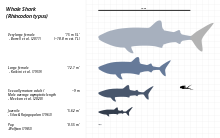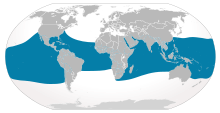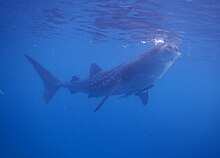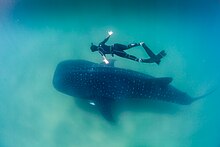Whale shark
| Whale shark Temporal range:
| |
|---|---|

| |
| Whale shark in the Andaman Sea around the Similan Islands | |

| |
| The size of various whale shark individuals with a human for scale | |
| Scientific classification | |
| Domain: | Eukaryota |
| Kingdom: | Animalia |
| Phylum: | Chordata |
| Class: | Chondrichthyes |
| Subclass: | Elasmobranchii |
| Subdivision: | Selachimorpha |
| Order: | Orectolobiformes |
| Family: | Rhincodontidae |
| Genus: | Rhincodon A. Smith, 1829[7][6] |
| Species: | R. typus
|
| Binomial name | |
| Rhincodon typus | |

| |
| Range of whale shark[needs update] | |
| Synonyms | |
| |
The whale shark (Rhincodon typus) is a slow-moving,
Whale sharks inhabit the open waters of all tropical oceans. They are rarely found in water below 21 °C (70 °F).[2] Whale sharks' lifespans are estimated to be between 80 and 130 years, based on studies of their vertebral growth bands and the growth rates of free-swimming sharks.[9][10][11] Whale sharks have very large mouths and are filter feeders, which is a feeding mode that occurs in only two other sharks, the megamouth shark and the basking shark. They feed almost exclusively on plankton and small fishes and pose no threat to humans.
The species was distinguished in April 1828 after the harpooning of a 4.6 m (15 ft) specimen in Table Bay, South Africa. Andrew Smith, a military doctor associated with British troops stationed in Cape Town, described it the following year.[12] The name "whale shark" refers to the animal's appearance and large size; it is a fish, not a mammal, and (like all sharks) is not closely related to whales.[13] In addition, its filter feeding habits are similar to baleen whales.
Description
Whale sharks possess a broad, flattened head with a large mouth and two small eyes located at the front corners.
Whale sharks have been found to possess
Evidence suggests that whale sharks can recover from major injuries and may be able to regenerate small sections of their fins. Their spot markings have also been shown to reform over a previously wounded area.[21]
The complete and annotated genome of the whale shark was published in 2017.[22]
Rhodopsin, the light-sensing pigment in the rod cells of the retina, is normally sensitive to green and used to see in dim light, but in the whale shark (and the bottom-dwelling cloudy catshark) two amino acid substitutions make the pigment more sensitive to blue light instead, the light that dominates the deep ocean. One of these mutations also makes rhodopsin vulnerable to higher temperatures. In humans, a similar mutation leads to congenital stationary night blindness, as the human body temperature makes the pigment decay.[23][24] This pigment becomes unstable in shallow water, where the temperature is higher and the full spectrum of light is present. To protect from this instability, the whale shark deactivates the pigment when in shallow water (as otherwise the pigment would hinder full color vision). In the colder environment at 2,000 meters below the surface where the shark dives, it is activated again.[25] The mutations thus allow the shark to see well at both ends of its great vertical range.[26][27] The eyes have also lost all cone opsins except LWS.[28]
Size
The whale shark is the largest non-
Large whale sharks are difficult to measure accurately, both on the land and in the water. When on land, the total length measurement can be affected by how the tail is positioned, either angled as it would be in life or stretched as far as possible. Historically, techniques such as comparisons to objects of known size and knotted ropes have been used for in-water measurements, but these techniques may be inaccurate.[33] In 2011, laser photogrammetry was proposed to improve the accuracy of in-water measurements.[33][35]
Reports of large individuals
Since the 1800s, there have been accounts of very large whale sharks. Some of these are as follows:
In 1868, the Irish natural scientist
Hugh M. Smith described a huge animal caught in a bamboo fish trap in Thailand in 1919. The shark was too heavy to pull ashore, and no measurements were taken. Smith learned through independent sources that it was at least 10 wa (a Thai unit of length measuring between a person's outstretched arms). Smith noted that one wa could be interpreted as either 2 m (6.6 ft) or the approximate average of 1.7 to 1.8 m (5.6–5.9 ft), based on the local fishermen.[37] Later sources have stated this whale shark as approximately 18 m (59 ft), but the accuracy of the estimate has been questioned.[14][8]
In 1934, a ship named the Maunganui came across a whale shark in the southern Pacific Ocean and rammed it. The shark became stuck on the prow of the ship, supposedly with 15 ft (4.6 m) on one side and 40 ft (12.2 m) on the other, suggesting a total length of about 55 ft (17 m).[38][39]
Scott A. Eckert & Brent S. Stewart reported on satellite tracking of whale sharks from between 1994 and 1996. Out of the 15 individuals tracked, two females were reported as measuring 15 m (49 ft) and 18 m (59 ft) respectively.[40] A 20.75 m (68.1 ft) long whale shark was reported as being stranded along the Ratnagiri coast in 1995.[41][42] A female individual with a standard length of 15 m (49.2 ft) and an estimated total length at 18.8 m (61.7 ft) was reported from the Arabian Sea in 2001.[43] In a 2015 study looking into the size of marine megafauna, McClain and colleagues considered this female as being the most reliable and accurately measured.[8]
On 7 February 2012, a large whale shark was found floating 150 kilometres (93 mi) off the coast of Karachi, Pakistan. The length of the specimen was said to be between 11 and 12 m (36 and 39 ft), with a weight of around 15,000 kg (33,000 lb).[44]
-
Jaws
-
Teeth
-
Eye
-
Close up showing eyeball denticles
-
Top of head
Distribution and habitat
The whale shark inhabits all tropical and warm-temperate seas. The fish is primarily
The whale shark is migratory
Seasonal feeding aggregations occur at several coastal sites such as the
In 2011, more than 400 whale sharks gathered off the
Growth and reproduction
Growth, longevity, and reproduction of the whale shark are poorly understood.[11][32][31] There was uncertainty as to whether vertebrae growth bands are formed annually or biannually, which is important in determining the age, growth, and longevity of whale sharks.[30][9][11] A 2020 study compared the ratio of Carbon-14 isotopes found in growth bands of whale shark vertebrae to nuclear testing events in the 1950-60s, finding that growth bands are laid down annually. The study found an age of 50 years for a 10 m (33 ft) female and 35 years for a 9.9m male.[31] Various studies looking at vertebrae growth bands and measuring whale sharks in the wild have estimated their lifespans from ~80 years and up to ~130 years.[9][10][11]
Evidence suggests that males grow faster than females in the earlier stages of life but ultimately reach a smaller maximum size.[29] Whale sharks exhibit late sexual maturity.[31] One study looking at free-swimming whale sharks estimated the age at maturity in males at ~25 years.[11]
Pupping of whale sharks has not been observed, but mating has been witnessed twice in
The capture of a ~10.6 m (35 ft) female in July 1996 that was pregnant with ~300 pups indicated that whale sharks are ovoviviparous.[10][56][57] The eggs remain in the body and the females give birth to live young which are 40 to 60 cm (16 to 24 in) long. Evidence indicates the pups are not all born at once, but rather the female retains sperm from one mating and produces a steady stream of pups over a prolonged period.[58]
On 7 March 2009, marine scientists in the Philippines discovered what is believed to be the smallest living specimen of the whale shark. The young shark, measuring only 38 cm (15 in), was found with its tail tied to a stake at a beach in Pilar, Sorsogon, Philippines, and was released into the wild. Based on this discovery, some scientists no longer believe this area is just a feeding ground; this site may be a birthing ground, as well. Both young whale sharks and pregnant females have been seen in the waters of St Helena in the South Atlantic Ocean, where numerous whale sharks can be spotted during the summer.[59][60]
In a report from Rappler last August 2019, whale sharks were sighted during WWF Philippines' photo identification activities in the first half of the year. There were a total 168 sightings – 64 of them “re-sightings” or reappearances of previously recorded whale sharks. WWF noted that “very young whale shark juveniles" were identified among the 168 individuals spotted in the first half of 2019. Their presence suggests that the Ticao Pass may be a pupping ground for whale sharks, further increasing the ecological significance of the area.[61]
Diet



The whale shark is a
The whale shark is an active feeder, targeting concentrations of plankton or fish. It is able to ram filter feed or can gulp in a stationary position. This is in contrast to the passive feeding basking shark, which does not pump water. Instead, it swims to force water across its gills.[10][65]
A juvenile whale shark is estimated to eat 21 kg (46 pounds) of plankton per day.[67]
The BBC program Planet Earth filmed a whale shark feeding on a school of small fish. The same documentary showed footage of a whale shark timing its arrival to coincide with the mass spawning of fish shoals and feeding on the resultant clouds of eggs and sperm.[63]
Whale sharks are known to prey on a range of planktonic and small nektonic organisms that are spatiotemporally patchy. These include krill, crab larvae, jellyfish, sardines, anchovies, mackerels, small tunas, and squid. In ram filter feeding, the fish swims forward at constant speed with its mouth fully open, straining prey particles from the water by forward propulsion. This is also called ‘passive feeding’, which usually occurs when prey is present at low density.[68]
Due their mode of feeding, whale sharks are susceptible to the ingestion of microplastics. As such, the presence of microplastics in whale shark scat was recently confirmed.[69]
Relationship with humans
Behavior toward divers
Despite its size, the whale shark does not pose any danger to humans. Whale sharks are docile fish and sometimes allow swimmers to catch a ride,[70][71][72] although this practice is discouraged by shark scientists and conservationists because of the disturbance to the sharks.[73] Younger whale sharks are gentle and can play with divers. Underwater photographers such as Fiona Ayerst have photographed them swimming close to humans without any danger.[74]

The shark is seen by divers in many places, including the
Conservation status
There is currently no robust estimate of the global whale shark population. The species is considered
It is listed, along with six other species of sharks, under the
In 2010, the Gulf of Mexico oil spill resulted in 4,900,000 barrels (780,000 m3) of oil flowing into an area south of the Mississippi River Delta, where one-third of all whale shark sightings in the northern part of the gulf have occurred in recent years. Sightings confirmed that the whale sharks were unable to avoid the oil slick, which was situated on the surface of the sea where the whale sharks feed for several hours at a time. No dead whale sharks were found.[82]
This species was also added to
Hundreds of whale sharks are illegally killed every year in China for their fins, skins, and oil.[84]
In captivity

The whale shark is popular in the few public aquariums that keep it, but its large size means that a very large tank is required and it has specialized feeding requirements.[85] Their large size and iconic status have also fueled an opposition to keeping the species in captivity, especially after the early death of some whale sharks in captivity and certain Chinese aquariums keeping the species in relatively small tanks.[86][87]

The first attempt at keeping whale sharks in captivity was in 1934 when an individual was kept for about four months in a netted-off natural bay in
Since the mid-1990s, several other aquariums have kept the species in Japan (
Outside Asia, the first and so far only place to keep whale sharks is Georgia Aquarium in Atlanta, United States.[88] This is unusual because of the comparatively long transport time and complex logistics required to bring the sharks to the aquarium, ranging between 28 and 36 hours.[90] Georgia keeps two whale sharks: two males, Taroko and Yushan, who both arrived in 2007.[95] Two earlier males at Georgia Aquarium, Ralph and Norton, both died in 2007.[87] Trixie died in 2020. Alice died in 2021. Georgia's whale sharks were all imported from Taiwan and were taken from the commercial fishing quota for the species, usually used locally for food.[90][96] Taiwan closed this fishery entirely in 2008.[96]
Human culture
In Madagascar, whale sharks are called marokintana in Malagasy, meaning "many stars", after the appearance of the markings on the shark's back.[97]
In the Philippines, it is called butanding and balilan.[98] The whale shark is featured on the reverse of the Philippine 100-peso bill. By law snorkelers must maintain a distance of 4 ft (1.2 m) from the sharks and there is a fine and possible prison sentence for anyone who touches the animals.[99]
Whale sharks are also known as jinbei-zame in Japan (because the markings resemble patterns typically seen on jinbei); gurano bintang in Indonesia; and ca ong (literally "sir fish") in Vietnam.[100]
The whale shark is also featured on the latest 2015–2017 edition of the Maldivian 1000
See also
References
- ^ "Rhincodon typus in the Paleobiology Database". Fossilworks. Retrieved 17 December 2021.
- ^ . Retrieved 19 November 2021.
- ^ "Appendices | CITES". cites.org. Retrieved 14 January 2022.
- ^ a b Smith, Andrew (5 November 1828). "Descriptions of New or imperfectly known Objects of the Animal Kingdom, found in the South of Africa". The South African Commercial Advertiser. Vol. 3, no. 145 – via Center for Research Libraries Document Delivery System. Reprinted in Penrith (1972).
- JSTOR 1442501.
- ^ a b Melville, R. V. (1981). "Opinion 1278. The Generic Name Rhincodon A. Smith, 1829 (Pisces): Conserved". The Bulletin of Zoological Nomenclature. 41 (4): 215–217.
- ^ Smith, Andrew (1829). "Contributions to the Natural History of South Africa, &c". The Zoological Journal. 4: 443–444.
- ^ .
- ^ ISSN 1323-1650.
- ^ a b c d e f Colman, J. G. Froese, Ranier; Pauly, Daniel (eds.). "Rhincodon typus". FishBase. Retrieved 17 September 2006.
- ^ ISSN 1323-1650.
- ^ Martin, R. Aidan. "Rhincodon or Rhiniodon? A Whale Shark by Any Other Name". ReefQuest Centre for Shark Research.
- PMID 20735591.
- ^ PMID 29991171.
- ^ OCLC 54364165.
- ^ "Whale Sharks, Rhincodon typus". MarineBio.org. Retrieved 17 May 2018.
- ^ Kaikini, A. S.; Ramamohana Rao, V.; Dhulkhed, M. H. (1959). "A note on the whale shark Rhincodon typus Smith, stranded off Mangalore". Central Marine Fisheries Research Unit, Mangalore.
- ^ Compagno, L. J. V. "Species Fact Sheet, Rhincodon typus". Food and Agriculture Organization of the United Nations. Retrieved 19 September 2006.
- PMID 32598385.
- ^ McGreevy, Nora. "Whale Sharks Have Tiny Teeth on Their Eyeballs". Smithsonian Magazine.
- PMID 33569175.
- PMID 28709399.
- ^ "How whale shark rhodopsin evolved to see, in the deep blue sea". ScienceDaily.
- ^ "Whale sharks see in dark due to mutation behind blindness in humans". The Japan Times. 9 April 2023.
- ^ "Whale Sharks Can See in the Dark Due to Genetic Mutation; Light-Sensing Pigment in Retina Works in Dim Environment | Science Times".
- PMID 36943890.
- ^ "Mutation behind night blindness in humans helps whale sharks see in the dark". www.science.org. Retrieved 26 March 2023.
- )
- ^ S2CID 221712078.
- ^ S2CID 20461057.
- ^ .
- ^ ISSN 0165-7836.
- ^ S2CID 7243391.
- ISSN 0165-7836.
- S2CID 6882935.
- OCLC 835888086.
- PMID 17732228.
- OCLC 1759776.
- ISBN 978-0-00-219960-5.
- S2CID 22173382.
- ^ Katkar, B.N. (1996). "Turtles and whale shark landed along ratnagiri coast, maharashtra". Marine Fisheries Information Service. 141: 20.
- ^ Venkatesan, V; Ramamurthy, N; Boominathan, N; Gandhi, A (2008). "Stranding of a whale shark, Rhincodon typus (smith) at Pamban, Gulf of Mannar" (PDF). Marine Fisheries Information Service. 198: 19–22.
- S2CID 37683420.
- ^ Hasan, Saad (10 February 2012). "Experts to cut up 40.1-foot long whale shark today". The Express Tribune.
- ^ IUCN. Retrieved 28 November 2020.
- . Retrieved 6 June 2022.
- ^ Public Library of Science (18 November 2015). "Whale sharks in Gulf of Mexico swim near the surface, take deep dives". phys.org. Retrieved 6 June 2022.
- ^ Howard, Brian C. (28 June 2016). "Whale Sharks Move in Mysterious Ways: Watch Them Online". National Geographic Society. Archived from the original on 28 June 2016. Retrieved 12 August 2016.
- ^ "Drive to conserve whale shark". The Hindu. 30 August 2017 – via www.thehindu.com.
- ^ Kaushik, Himanshu (30 August 2014). "Whale sharks found off Gujarat coast no expats, they are Indian". The Times of India. Retrieved 12 May 2016.
- ^ Dekker, Stefanie (17 July 2020). "'What a privilege': Swimming with endangered whale sharks in Qatar". Aljazeera. Retrieved 28 July 2020.
- PMID 21559508.
- ^ Dove, Alistair (27 January 2015), Yucatan Whale Sharks Swimming in Troubled Waters, archived from the original on 7 November 2017
- OCLC 8162956757.
- ^ "Attempted Whale Shark Mating Caught on Camera for the First Time in History". livescience.com. 24 June 2019.
- S2CID 22250254.
- ^ Clark, Eugenie. "Frequently Asked Questions". Sharklady. Archived from the original on 5 March 2001. Retrieved 26 September 2006.
- doi:10.3354/esr00300.
- ^ "Tiny whale shark rescued – World news – World environment". Associated Press via NBC News. 2009.
- ^ "St Helena whale sharks cause stir in Atlanta". South Atlantic Media Services. 14 November 2013. Archived from the original on 18 May 2023. Retrieved 12 May 2016.
- ^ "'Largest number in years': Over 100 new whale sharks spotted in Donsol". Rappler.com. 30 August 2019. Retrieved 4 March 2020.
- ^ Morelle, Rebecca (17 November 2008). "Shark-cam captures ocean motion". BBC News. Retrieved 30 July 2009.
- ^ a b Jurassic Shark (2000) documentary by Jacinth O'Donnell; broadcast on Discovery Channel, 5 August 2006
- PMID 20817493.
- ^ a b Martin, R. Aidan. "Elasmo Research". ReefQuest. Retrieved 17 September 2006.
- ^ "Whale shark". Ichthyology at the Florida Museum of Natural History. 11 May 2017. Archived from the original on 5 September 2006. Retrieved 17 September 2006.
- ^ Schmidt, Jennifer V. (4 December 2010). "Whale Sharks are BIG eaters!". The Shark Research Institute. Archived from the original on 5 May 2015. Retrieved 24 April 2016.
- ^ "Rhincodon typus (whale shark)". Animal Diversity Web. Retrieved 1 September 2016.
- PMID 34939039.
- ^ ISBN 978-92-5-104543-5.
- ^ "Favorite Wins of 2013". Break.com. p. 1:24. Archived from the original on 26 August 2014. Retrieved 24 September 2014.
- ^ Robbins J. (18 July 2017). Watch Iranian fisherman 'surf' on top of a whale shark across the Persian Gulf. International Business Times. Retrieved on 29 September 2017
- ^ Whitehead, Darren Andrew (2014) Establishing a quantifiable model of whale shark avoidance behaviours to anthropogenic impacts in tourism encounters to inform management actions, University of Hertfordshire.
- ^ a b Pictures of the Day: Tuesday, Aug. 04, 2009. Time magazine, "A 40-foot whale shark and a brave snorkeler swim off the South African coast."
- ^ Hawes, Craig (2 April 2013) Snorkelling with whale sharks in Djibouti. gulfnews.com
- PMID 35533277.
- OCLC 1042901090.
- ^ "Memorandum of understanding on the conservation of migratory sharks" (PDF). Convention on migratory species. p. 10. Retrieved 13 February 2012.
- ^ Whale Sharks Receive Protection in the Philippines Archived 16 February 2020 at the Wayback Machine. hayop.0catch.com. 27 March 1998
- ^ National Regulations on Whale Shark fishing. Department of Sustainability, Environment, Water, Population and Communities.
- ^ COA bans fishing for whale sharks. Taipei Times, 27 May 2007, p. 4.
- ^ Handwerk, Brian (24 September 2010) Whale Sharks Killed, Displaced by Gulf Oil? National Geographic News.
- ^ Whale shark. cites.org
- ^ Hilton/Greenpeace, Paul (5 February 2014). "Hundreds of sharks killed in China". ABC News.
- ^ OCLC 1001957014.
- ^ "Whale Shark's Death Sparks Debate". wsbtv. 30 November 2007. Archived from the original on 25 March 2010.
- ^ a b c Moore, M. (25 October 2010). "Conservationists round on Chinese whale shark aquarium". The Telegraph. Archived from the original on 12 January 2022. Retrieved 8 November 2017.
- ^ a b c Mollet, H. (September 2012). "Whale Shark Rhincodon typus Smith, 1828 in Captivity". Retrieved 8 November 2017.
- ^ "令和二年度 沖縄美ら海水族館 年報" (PDF). Okinawa Churaumi Aquarium. Retrieved 28 May 2021.
- ^ OCLC 1001957014.
- ^ "Dubai hotel releases whale shark back into the wild". Associated Press. 20 March 2010. Archived from the original on 7 August 2015.
- OCLC 1001957014.
- ^ Chua, G. (16 May 2009). "No whale sharks at Sentosa IR". Wild Singapore News. Retrieved 8 November 2017.
- ^ "Resorts World considering alternatives to whale shark exhibit". AsianOne Travel. 16 May 2009. Archived from the original on 9 June 2013.
- ^ "Aquarium gains two new whale sharks". CNN. 1 June 2007. Archived from the original on 3 June 2007. Retrieved 1 June 2007.
- ^ a b Sundquist, T. (18 September 2013). "Transporting the World's Largest Fish: A Whale [Shark] of a Task". Promega Connections. Retrieved 8 November 2017.
- ^ Briggs, Helen (17 May 2018). "Madagascar emerges as whale shark hotspot". BBC News. Retrieved 12 September 2018.
- ^ Ocean Ambassadors – Sharks. Oneocean.org. Retrieved 23 May 2013.
- ^ Cannon, Marisa (21 July 2015). "Swimming with whale sharks in the Philippines". cnn.com. CNN. Retrieved 16 August 2015.
- ^ "Whale Shark". Discovery.com. 5 September 2013. Archived from the original on 4 March 2009. Retrieved 3 November 2011.
Further reading
- Colman, J.G. (December 1997). "A review of the biology and ecology of the whale shark". J. Fish Biol. 51 (6): 1219–34. PMID 29991171.
- FAO web page on Whale shark
- "Whale Sharks, Whale Shark Pictures, Whale Shark Facts". Animals, Animal Pictures, Wild Animal Facts. 10 September 2010. Archived from the original on 16 January 2010.
External links
- Whale Shark Photograph-identification Library
- Whale Shark And Oceanic Research Center
- Maldives Whale Shark Research Program
- Whale Sharks: Gentle Giants of the Seas
- Foundation for the Protection of Marine Megafauna
- Whale shark, Rhincodon typus at marinebio.org
- Whale Shark Fact Sheet, Fisheries Western Australia
- Albino whale shark photographed in Galapagos
- Photographs National Geographic
- A whale shark recorded defecating
- Photos of Whale shark on Sealife Collection






